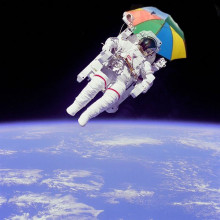Going to space sounds like it would be really cool, but what would happen to your body when you're there? John Noone studies exactly this sort of thing...
In this episode

- Naked Body: Your body in space
Naked Body: Your body in space
John Noone, Dublin City University
Going to space sounds like it would be really cool, but what would happen to your body when you're there? John Noone studies exactly this sort of thing...
Human beings have been exploring space for years. From launching Sputnik in 1957 to the Apollo 11 crews landing on the moon in 1969, our exploration of space has been very rewarding. However, within our 50 years of space travel we have only ever managed to propel 536 people into space, so we’re still learning what happens to human beings as they float in orbit.
Although many people believe that there is no gravity out in space, in fact the presence of planets and other large objects around us means that we do experience a very small fraction of the normal gravitational pull that we are accustomed to on earth. Scientists call this “microgravity”, but its effect is so small that astronauts will still float around inside their space-ships.
Large stints in a microgravity environment like space subject astronauts to a multitude of changes to their biology. Their bodies adapt to the reduced gravity, and some systems such as their bones, muscle, blood supply, and even their vision will start to change. The longer they are in space, the larger these changes become. These alterations put our brave astronauts at an increased risk of developing a series of diseases such as the metabolic syndrome and cardiovascular disease, when they return to earth.
One of the most profound changes to the body because of microgravity is a decrease in bone strength. Throughout life our bones are broken down by large cells called “osteoclasts” and are reformed by “osteoblasts”: this is a balancing act which occurs constantly on Earth. However, in microgravity our bones are not required to support as much weight! Therefore our osteoclasts breakdown bone more than osteoblasts build it back up again, reducing our bone density. This is a “use it or lose it” model, weakening their bones while they are in space, putting our astronauts at increased risk of bone breaks and fractures upon returning to Earth. With special training when they are back home, however, their bone strength can be restored again.
With a lack of gravity, the body doesn’t know which way up is, so has no idea how to distribute blood normally. Being in space increases blood pooling in the head and reduces blood in the legs and lower extremities. You can see this because astronauts often have a “puffy-face” appearance. This change also affects our heart and lungs, effectively redistributing blood flow around the body, altering the shape and function of the heart.
Increased pooling of blood in the head raises the pressure around the brain and the eye, flattening the back of the eye, impairing their vision. This is also linked to alterations in balance, both of which are pretty important!
This change to fluid distribution also means that we see up to a 10% decrease in muscle mass in astronauts after just a few weeks of microgravity. These reductions put our astronauts at increased risk of developing diabetes-like conditions, which we can also become more susceptible to as we get older. Therefore long-term space travel is effectively an accelerated aging process!
In order to reduce the risk of problems, astronauts have to exercise for almost 2 hours every day while in space! This slows some of these changes, but it doesn’t stop them. At present, scientists are developing alternative countermeasures in order to face the challenge of getting our astronauts “to infinity and beyond”.










Comments
Add a comment